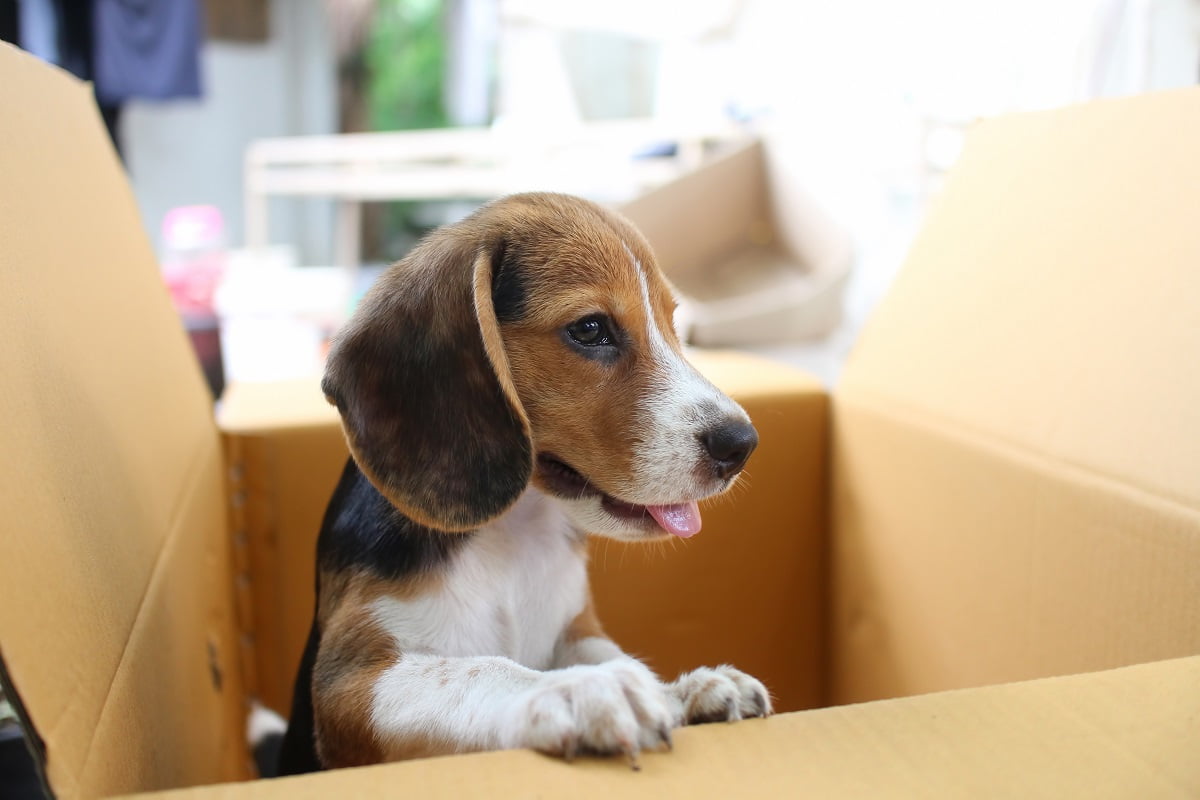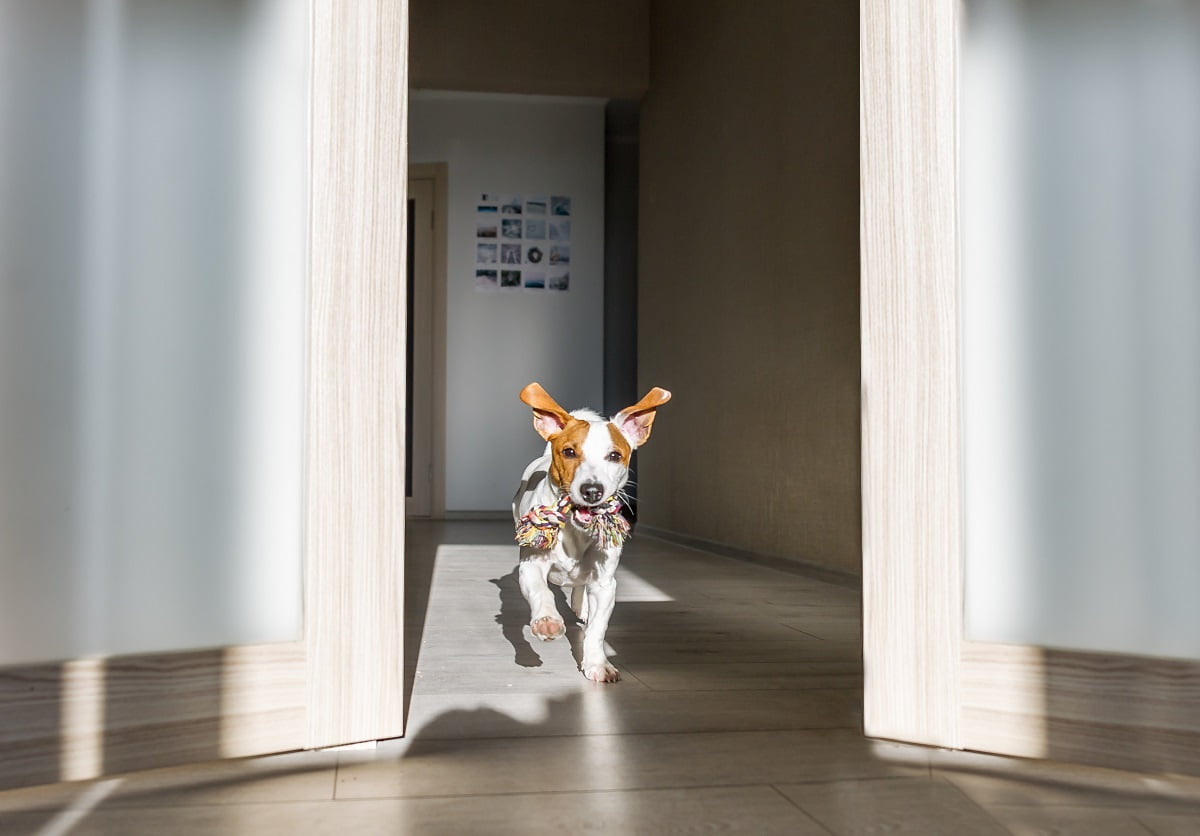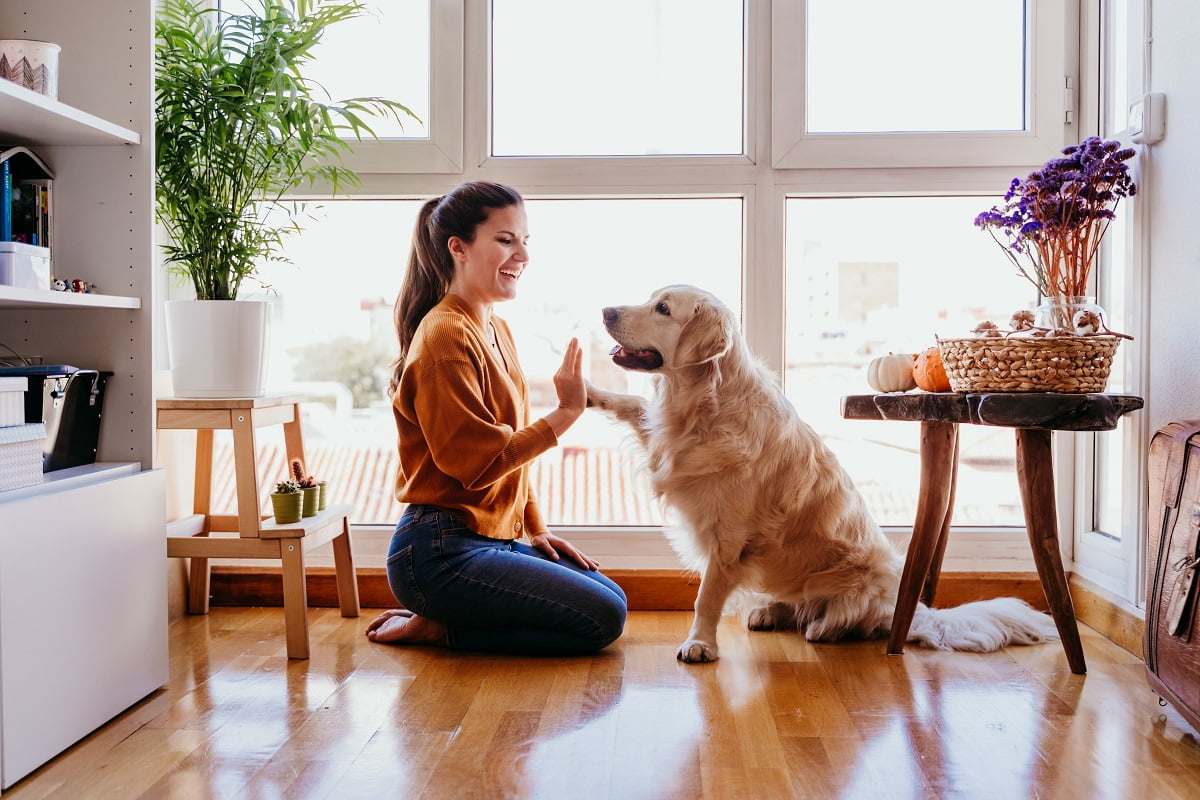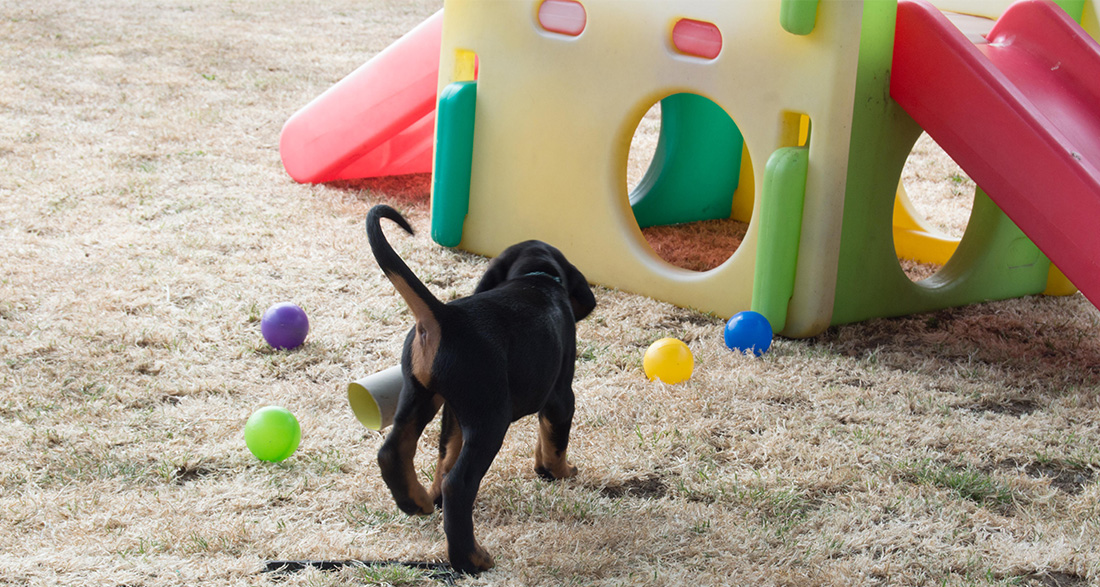Exercise and outdoor activities are particularly important for dogs – but experienced dog owners know that their four-legged friend also needs to be mentally stimulated. We’ll show you six fun indoor game ideas to keep your dog mentally engaged. Even as the weather gets better, it’s important for the dog to be able to be ideally entertained indoors. Of course, games at home never replace daily walks or outings, but it’s important for your dog to also be able to engage cognitively. We’ll explain why puzzle games and other dog games are important for the dog and the dog owner.
- Puzzle Games and Search Games for Dogs: Why Are They Important?
- 1. Indoor Dog Game: Unwrapping
- 2. Search Game: Nose Work is Challenging Indoors Too
- 3. Dog Game: Mini Obstacle Course in the Living Room Adds Action
- 4. Fetching Provides Great Fun at Home
- 5. Teaching Tricks is a Great Indoor Activity
- 6. The Classic: Tug-of-War Games for the Dog
- Puzzle Games and Co.: 5 Golden Rules for Indoor Dog Games
Puzzle Games and Search Games for Dogs: Why Are They Important?
The especially clever animals love intelligence games or puzzle games. These are suitable for dogs of all ages. They not only provide fun but also strengthen the bond with the dog. In addition, search games are also beneficial for the dog.
Furthermore, playing indoors is a welcome pastime especially for rainy days. Give your dog a little brain workout with these exciting home game ideas that encourage thinking!
1. Indoor Dog Game: Unwrapping
Just like us humans, dogs also enjoy being able to unwrap a small gift. Wrap food pieces or a toy in kitchen paper and place the whole thing in a box. You can adjust the difficulty level: the better the “gift” is wrapped, the more effort your dog has to make.
Here, your dog’s creativity is required: he must find a way to get to his beloved toy or treats – he will dig vigorously and test his agility. But be careful! Never leave your dog unattended while doing this and make sure he doesn’t swallow any of the wrapping material.

2. Search Game: Nose Work is Challenging Indoors Too
Even the dog’s nose can be trained. Have your dog sit down. Then make him aware of an object in your hand, such as a stuffed animal or a sock. Place it within sight of the dog while your dog continues to sit. Only on your command should your four-legged friend start searching.
Alternatively, you can also put treats in a box with scent holes and let your four-legged friend search for them. The same goes for using just treats. The exercise has many advantages:
- Waiting for your cue helps the dog gain impulse control.
- Your four-legged friend can learn to rely solely on his nose and use his unique sense of smell effectively.
If the dog is already a bit more practiced, he shouldn’t see where the treat or toy is hidden. Especially popular for search games are also so-called snuffle mats, where food pieces can be hidden.
But please make sure not to overwhelm your dog: Nose work can quickly become tiring for dogs. Five minutes are completely sufficient for starters.
3. Dog Game: Mini Obstacle Course in the Living Room Adds Action
If it’s allowed to be a bit more action-packed, you can quickly turn your living room into a mini obstacle course: build a tunnel by setting up several chairs in a row. Make sure that the height of the chairs is not too low for your dog. An obstacle is quickly assembled from two buckets and a broomstick.
It’s also possible to set up cones to let your dog run through in a slalom. Or: form a circle with your arms and let your dog (if he’s the appropriate size) jump through it. The possibilities are almost limitless! Just make sure that the dog still has enough room to move despite the obstacles and isn’t overwhelmed.

4. Fetching Provides Great Fun at Home
Teaching your dog to fetch or further improving his existing skills can bring a lot of fun to both you and your furry friend.
For example, roll a ball away from yourself, but allow your dog to fetch it only after a short time. Here, too, your dog’s impulse control can be trained.
5. Teaching Tricks is a Great Indoor Activity
To mentally stimulate your dog, it’s beneficial to teach him various commands. Ideally, use the time spent together at home to reinforce already known basic commands.
But if you’re in the mood for something new, you can teach your dog to tidy up toys: Place a toy on the floor and encourage your dog to bring it to you. You sit next to a box where the toy should be placed. Hold your hand over the container and initially let the dog give you the toy in your hand. As the training progresses, move your hand away – this way, the dog learns to put the toy in the box.

6. The Classic: Tug-of-War Games for the Dog
Tug-of-war games offer an excellent opportunity for your dog to release excess energy at home. Special tug-of-war toys or a towel are particularly suitable for this. Make sure the object is sturdy and won’t suddenly tear. Also, there must be no buttons on the fabric – they could end up in the dog’s throat.
Also to consider: Tug-of-war games are only suitable for dogs that do not react aggressively – the game must be accepted to stop at your command. Your dog must not defend his prey. Once the relationship between human and dog is clear, there is nothing standing in the way of shared tug-of-war fun.
Puzzle Games and Co.: 5 Golden Rules for Indoor Dog Games
When it comes to indoor games, always adhere to these 5 golden rules:
1. Regular mental exercises are important:
Ensure that your dog can expend cognitive energy regularly and incorporate puzzle games deliberately. If he doesn’t have the opportunity to do so, it can have dire consequences:
- He’ll find his own entertainment, such as chewing on furniture.
- A dog that is constantly bored may even become ill.
So make sure your dog is mentally stimulated as well as physically.
2. Puzzle games are not a substitute for outdoor activities:
It’s important for your dog to express and demonstrate his intelligence. However, indoor games are by no means a substitute for daily outdoor walks!
Your dog needs enough exercise – this can never be provided solely indoors.
3. Maintain control:
You decide when and how often to play. When the game is over, you must remain firm, even if your dog asks for more. Of course, you should spend enough time with your furry friend, but your dog must learn that you decide when it’s over.
4. The right balance is crucial:
Dogs love puzzle games – but don’t overdo it. Don’t set fixed times for them either, as your dog may start anticipating the game and eventually demand it specifically. The golden mean is important here: engage your dog thoroughly but without overwhelming him.
5. Plan rest breaks:
Just like us humans, dogs can only concentrate for a certain amount of time. Pay attention to your dog: how does he react to certain games? If he’s overwhelmed, it may manifest in behaviors such as scratching, licking his mouth frequently, or restlessness. If your dog yawns frequently and doesn’t want to participate properly anymore, you should end the playtime for today.


